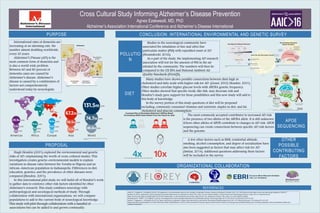
Proposal Presentation
- 1. Cross Cultural Study Informing Alzheimer’s Disease Prevention Agnes Ezekwesili, MD, PhD Alzheimer’s Association International Conference and Alzheimer’s Disease International International rates of dementia are increasing at an alarming rate, the number almost doubling worldwide, every 20 years. Alzheimer’s Disease (AD) is the most common form of dementia and is also a world wide problem. Between 60 and 80 percent of dementia cases are caused by Alzheimer’s disease. Alzheimer’s disease is caused by a combination of factors not comprehensively understood today by neurologists. Hugh Hendrie (2001) explored the environmental and genetic risks of AD, emphasizing the worth of cross-cultural studies. This investigation creates genetic-environmental models to explain variations in disease rates between the Yoruba in Nigeria and an African-American population in Indianapolis. Differences in diet, education, genetics, and the prevalence of other diseases were compared (Hendrie, 2001). In this international pilot study we will build off of Hendrie’s work to gather data to reinforce other risk factors identified by other Alzheimer's research. This study combines neurology with anthropological and sociological methods of study. Through collaboration with international organizations, we will compare populations to add to the current body of neurological knowledge. This study will pilot through collaboration with a handful of associations but can be added to and grown continually. PROPOSAL PURPOSE APOE SEQUENCING ORGANIZATIONAL COLLABORATION REFERENCES The most commonly accepted contributor to increased AD risk is the presence of two alleles of the APOE4 allele. It is still unknown if/how other alleles of APOE contribute to changes in AD risk. APOE sequencing can create connections between specific AD risk factors and the genome. A few other factors such as BMI, residential altitude, smoking, alcohol consumption, and degree of socialization have also been suggested as factors that may affect risk for AD (Imtiaz, 2014). Additional questions addressing these factors will be included in the survey. OTHER POSSIBLE CONTRIBUTING FACTORS Grant W., Campbell A., & Itzhaki R. (2002). The significance of environmental factors in the etiology of Alzheimer’s disease. Journal of Alzheimer’s Disease 4(3), 179-189. Retrieved from: https://www.ncbi.nlm.nih.gov/pubmed/12226537 Hendrie H. (2001). Exploration of Environmental and Genetic Risk Factors for Alzheimer’s Disease: The Value of Cross-Cultural Studies. Current Directions in Psychological Science 10(3), 98-101. Retrieved from: https://www.researchgate.net/publication/247781189_Exploration_of_Environmental_and_Genetic_Risk_Factors_for_Alzheimer's_Disease_The_Value_of_Cross-Cultural_Studies Heusinkveld H., Wahle T., & Campbell A. (2016). Neurodegenerative and neurological disorders by small inhaled particles. Neurotoxicology 56, 94-106. doi:10.1016/j.neuro.2016.07.007 Imtiaz B., Tolppanen A., & Kivipelto M. (2014). Future directions in Alzheimer’s disease from risk factors to prevention. Biochemical Pharmacology,88 (4), 661-670. http://dx.doi.org/10.1016/j.bcp.2014.01.003 Setting and Reviewing Standards to Control Particulate Matter (PM) Pollution. (2016). US Environmental Protection Agency. Retrieved from: https://www.epa.gov/pm-pollution/setting-and-reviewing-standards-control-particulate-matter-pm- pollution#standards CONCLUSION: INTERNATIONAL ENVIRONMENTAL AND GENETIC SURVEY https://stanfordhealthcare.org/content/dam/SHC/conditions/brains-nerves/images/alzhemers-diagram- brain2.jpg http://www.worldalzreport2015.org/downloads/global-impact-of-dementia- infographic.pdf Many studies have shown possible connections between diets high in cholesterol and fatty acids with higher risk for AD. (Grant, 2002; Hendrie, 2001) Other studies correlate higher glucose levels with APOE4 genetic frequency. Other studies showed that specific foods, like fish, may decrease risk and Hendrie’s study gave support for these possibilities and this new study will add to this body of knowledge. In the survey portion of this study questions of diet will be proposed including: commonly consumed vitamins and nutrients, staples in diet, and fat, cholesterol and glucose consumption. DIET http://assets.motherjones.com/environment/2015/06/pollution_graphics_960x230- 01.png Studies in the neurological community have associated the inhalation of fine and ultra fine particulate matter (PM) with expedited onset of AD (Heusinkveld, 2016). As a part of the study, the implementing AD research association will test for the amount of PM in the air inhaled by the community. The numbers will then be compared to the US EPA and National Ambient Air Quality Standards (NAAQS). POLLUTIO N http://curealz.org/sites/default/files/AboutAlz_InheritAPOE4_0.jpg http://www.pcrm.org/sites/default/files/images/media/releases/alzheimers-graphic.jpg http://assets.motherjones.com/environment/2015/06/pollution_graphics_960x230- 02.png